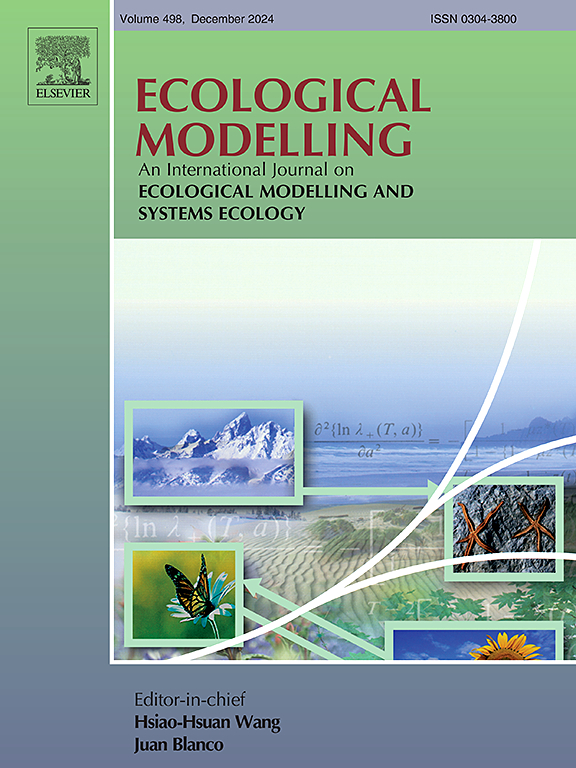建模系统动力学作为社会生态学的观点,以支持人与海狸的相互作用
IF 3.2
3区 环境科学与生态学
Q2 ECOLOGY
引用次数: 0
摘要
海狸是一种半水生哺乳动物,对淡水生态系统产生了重大影响,创造了利益和挑战,特别是在人类密切互动的地区。由于涉及许多变量,管理人与海狸的互动是一个多方面的问题,但这些互动的复杂性可以使用系统动力学模型有效地分析。这些模型在许多情况下使用,包括野生动物管理,以模拟各种管理政策并评估其效果。本研究通过开发一个系统动力学模型来解决文献中的空白,该模型研究了人类与海狸互动产生的利益和冲突。该模型使用Vensim PLE软件实现,综合了定性和定量数据,模拟了四种模拟情景:生态、社会、经济和政策制定。该研究以意大利皮埃蒙特地区的Ivrea湖区为例,考察了海狸种群的动态、生态系统服务的提供、社会观念和管理策略。模型预测强调,海狸数量在逻辑上稳定,影响生态系统服务和剩余资本,而社会接受大大降低了管理成本和社会压力。最佳预算分配和综合战略已成为可持续管理和缓解冲突的关键。总体而言,预测表明,优先考虑预防和积极参与当地社区的综合方法可以改善生态结果和社会对海狸的接受程度。该模型是评估管理策略和促进利益相关者参与的有用决策和讨论工具。未来的研究应该通过探索不同背景下与海狸有关的其他冲突和利益来扩展这些结果。本文章由计算机程序翻译,如有差异,请以英文原文为准。
Modelling system dynamics as a socio-ecological perspective to support human-beaver interactions
Beavers are semi-aquatic mammals that significantly impact on freshwater ecosystems, creating benefits and challenges, particularly in areas with close human interaction. Managing human-beaver interactions is a multifaceted issue due to the many variables involved, but the complexity of these interactions can be analysed effectively using system dynamics models. These models are used in many contexts, including wildlife management, to simulate a variety of management policies and assess their effects. The present study addressed gaps in the literature by developing a system dynamics model that examined both the benefits and conflicts that arise from human-beaver interactions. The model, implemented using Vensim PLE software, synthesised qualitative and quantitative data to simulate four simulation scenarios: ecological, social, economic, and policy making. The study examined the dynamics of beaver populations, ecosystem service provision, social perceptions, and management strategies in a case study of the Ivrea lakes area in the Piedmont region (Italy). Model predictions highlights that beaver populations stabilized logistically, influencing ecosystem services and residual capital, while social acceptance stongly reduced management costs and social pressure. Optimal budget allocation and combined strategies emerged as key to sustainable management and conflict mitigation. Overall, predictions suggest that an integrated approach that prioritises prevention and actively engages local communities can improve both ecological outcomes and social acceptance of beavers. The model is a useful decision and discussion tool for assessing management strategies and facilitating stakeholder involvement. Future studies should expand on these results by exploring additional beaver-related conflicts and benefits in diverse contexts.
求助全文
通过发布文献求助,成功后即可免费获取论文全文。
去求助
来源期刊

Ecological Modelling
环境科学-生态学
CiteScore
5.60
自引率
6.50%
发文量
259
审稿时长
69 days
期刊介绍:
The journal is concerned with the use of mathematical models and systems analysis for the description of ecological processes and for the sustainable management of resources. Human activity and well-being are dependent on and integrated with the functioning of ecosystems and the services they provide. We aim to understand these basic ecosystem functions using mathematical and conceptual modelling, systems analysis, thermodynamics, computer simulations, and ecological theory. This leads to a preference for process-based models embedded in theory with explicit causative agents as opposed to strictly statistical or correlative descriptions. These modelling methods can be applied to a wide spectrum of issues ranging from basic ecology to human ecology to socio-ecological systems. The journal welcomes research articles, short communications, review articles, letters to the editor, book reviews, and other communications. The journal also supports the activities of the [International Society of Ecological Modelling (ISEM)](http://www.isemna.org/).
 求助内容:
求助内容: 应助结果提醒方式:
应助结果提醒方式:


